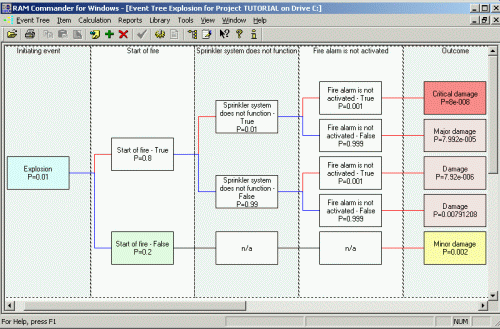Event Tree Analysis (ETA)
Event Trees are one of the most widely used methods in system risk analysis. It is an inductive failure analysis performed to determine the consequences of single failure for the overall system risk or reliability. Event Tree Analysis (ETA) uses similar logic and mathematics as Fault Tree Analysis, but the approach is different – FTA uses deductive approach (from system failure to it’s reasons) and ETA uses the inductive approach (from basic failure to it’s consequences).
An event tree itself is a visual representation of single failure sequences, it’s influence on other events and on the whole system.
ETA Module Features
• User-friendly and convenient tree building interface (zoom, export to clipboard as metafile, print, etc.)
• Customizable graphical representation (diagram elements colors, styles etc.)
• Events Library
• Event Probability assessment models:
o user-defined
o calculated (repairable/unrepairable/constant mission time/periodical tests)
o linked to product tree element
o linked to FMECA Failure Mode, NHE or End Effect
o linked to Fault Tree basic event
o linked to Fault Tree gate or tree top event
• Different Event logic types:
o Binary logic
– True/False
– Success/Failure
o Multiple alternatives (for events where not only True/False or Success/Failure outcomes are considered)
• Different Event probability types
o Equal event probabilities in all sequences
o Different event probabilities in different sequences (conditional probabilities)
• Customizable graphical representation (diagram elements colors, styles etc.)
• Events Library
• Event Probability assessment models:
o user-defined
o calculated (repairable/unrepairable/constant mission time/periodical tests)
o linked to product tree element
o linked to FMECA Failure Mode, NHE or End Effect
o linked to Fault Tree basic event
o linked to Fault Tree gate or tree top event
• Different Event logic types:
o Binary logic
– True/False
– Success/Failure
o Multiple alternatives (for events where not only True/False or Success/Failure outcomes are considered)
• Different Event probability types
o Equal event probabilities in all sequences
o Different event probabilities in different sequences (conditional probabilities)

